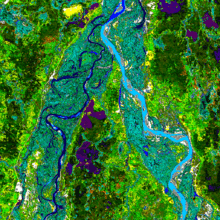Bananal Island
| Native name: <span class="nickname" ">Ilha do Bananal | |
|---|---|
 Landsat image of the northern end of Rio das Mortes-Cristalino peninsula adjoint southwest to Bananal Island by Araguaia river | |
 Location in Brazil | |
| Geography | |
| Location | State of Tocantins, Brazil |
| Coordinates | 11°20′S 50°25′W / 11.333°S 50.417°W |
| Area | 19,162.25 km2 (7,398.59 sq mi) |
| Area rank | 49th |
| Country | |
|
Brazil | |
| State | Tocantins |
| Additional information | |
| Designated | 4 October 1993 [1] |
Bananal Island (Portuguese: Ilha do Bananal, IPA: [banaˈnaw]) is a large river island formed from the bisection of the Araguaia River, in southwestern Tocantins, Brazil. The island is formed by a fork in a very flat section of the Araguaia River. Bananal Island is the second largest fluvial island in the world, at 350 km (217 mi) long and 55 km (34 mi) wide.[2] Its total area is 19,162.25 km² (7,400 mi²).
Environmental and cultural protection
Bananal Island is a nature and culture preserve. In accordance with Article 28 of the Statute of Indian Law (Artigo 28 do Estatuto do Indío-lei) No. 6001 laid out in 19 December 1973, an area of 5,577.26 km² is preserved as Araguaia National Park and further 13,584.99 km² as cultural preserve for indigenous peoples. The northern third of the island, which is designated as a national park, is a popular destination for ecotourism. The southern two-thirds are Indigenous Territories.
Inhabitants
Although Brazilians of non-native descent lived on the island in the past, today only natives populate the island.
At least four tribes live on Bananal Island: the Javaés, Karajá, Ava-Canoeiro, and Tuxá. There are sixteen aldeias or villages on the island:
Barra do Rio, Barreira Branca, Boa Esperança, Boto Velho, Cachoeirinha, Fontoura, JK, Kanoanã, Kaxiwe, Macaúba, Santa Isabel, São João, Txoude, Txuiri, Wari-Wari, Watau.
There are no bridges to the island from the states of Tocantins to the east nor from Mato Grosso to the west. For the greater majority of the year, the only transport to the island is by boat. However, for a few weeks during the dry season (June - August) the river is low enough that the island can be reached by car. The villages have roads wide enough for cars and tractors even though the main forms of transport are by horse, bicycle, and foot.
Municipalities
From north to south, the island forms the western portions of the municipalities of Pium, Lagoa da Confusão, and Formoso do Araguaia, in southwestern Tocantins.
References
- ↑ "Ramsar List". Ramsar.org. Retrieved 15 April 2013.
- ↑ Island Superlatives